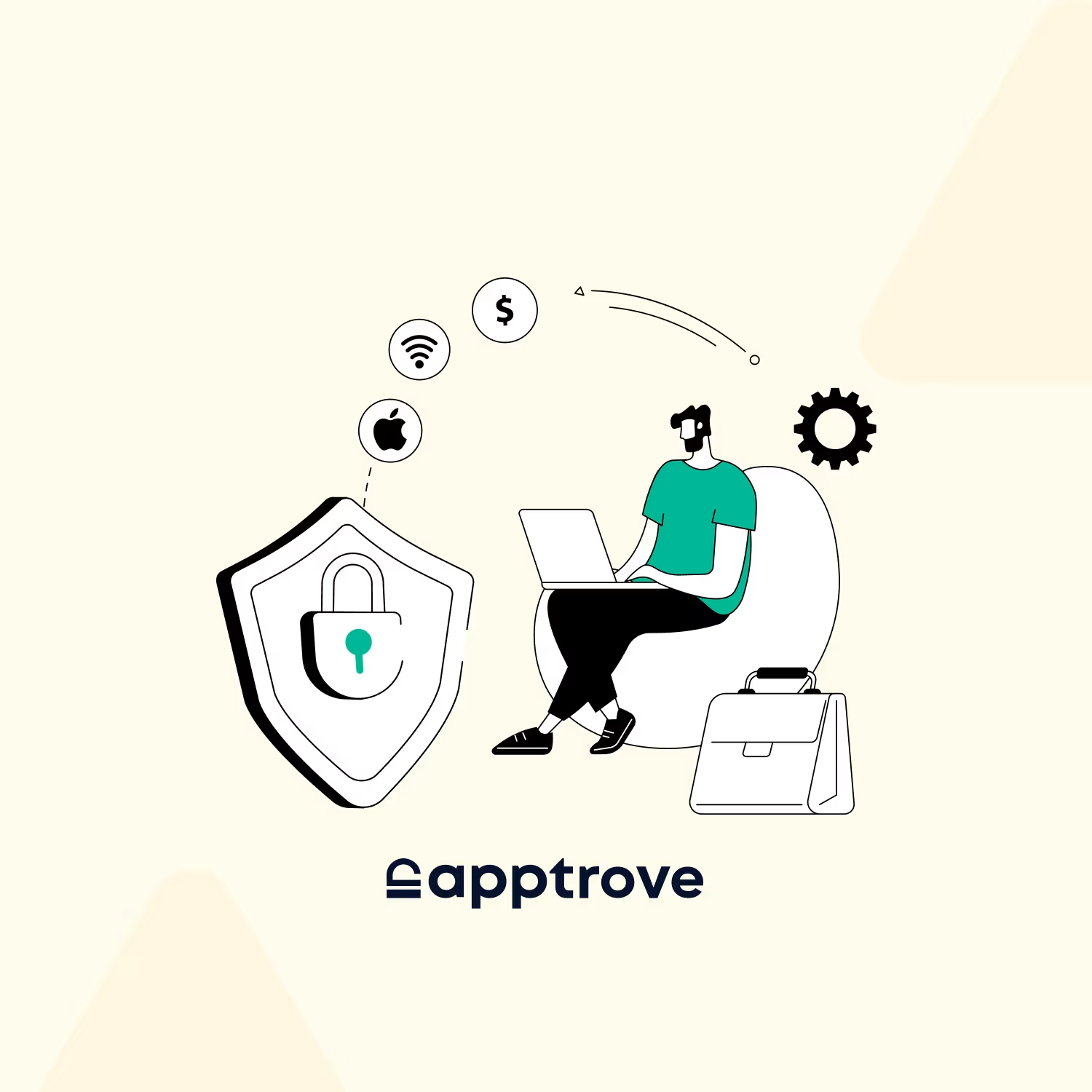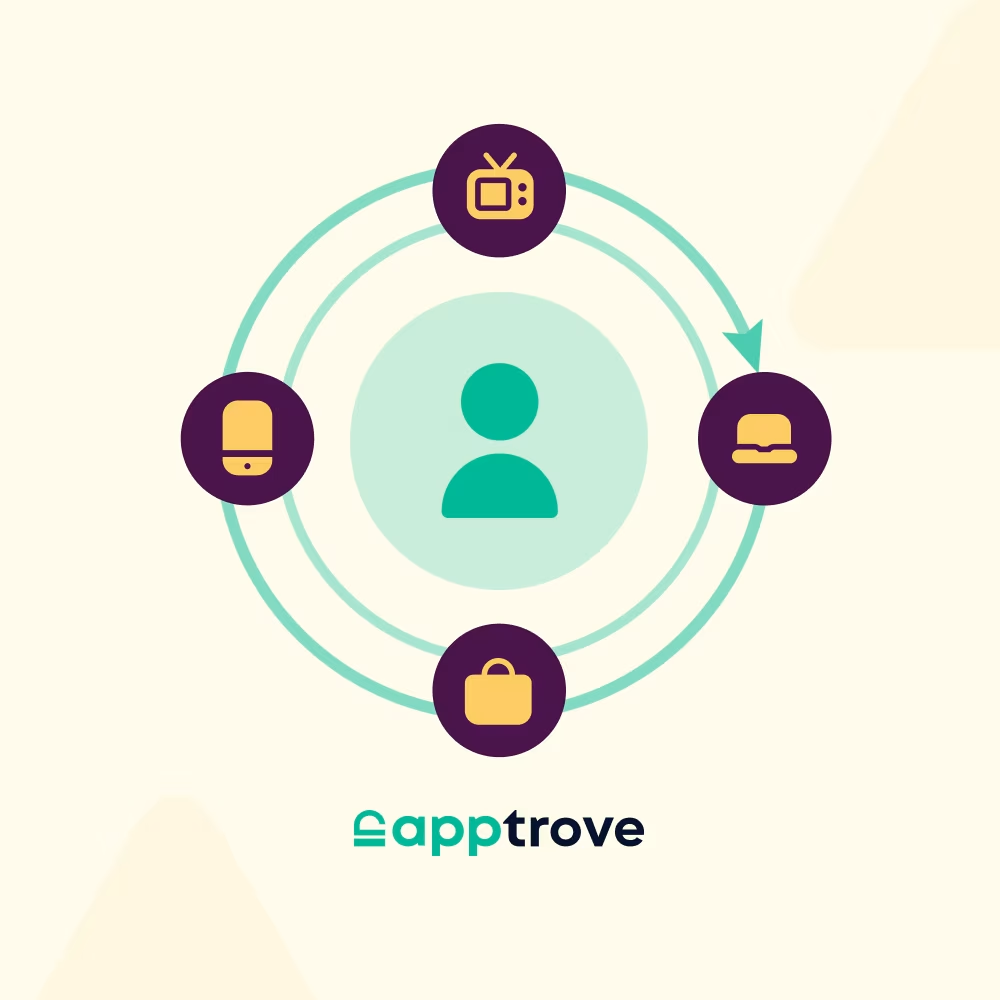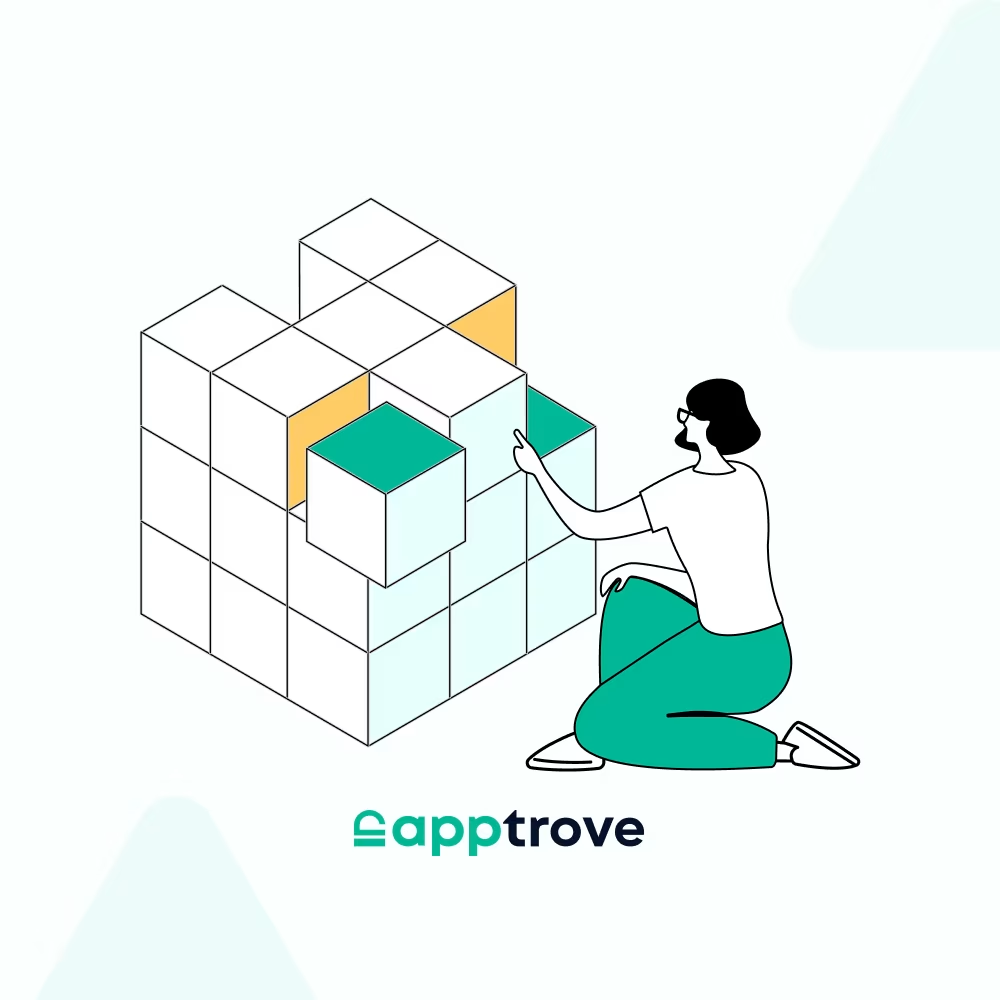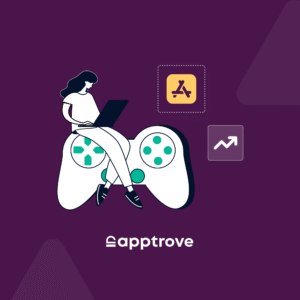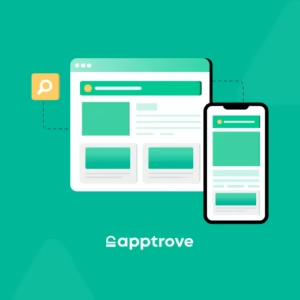Welcome to the SKAN Era
The privacy-first revolution is real, it’s completely changing how the digital world operates. As governments and users demand more control over personal data, Apple has stepped up, reshaping how marketers track and measure user activity on iPhones and iPads.
Meet SKAN, Apple’s SKAdNetwork, the privacy-focused attribution system that’s now the go-to for app marketers and advertisers. Since Apple restricted IDFA (Identifier for Advertisers), SKAN has become the main way to track iOS app installs. Whether you’re trying to measure ad campaign results or boost user engagement, getting comfortable with SKAN is absolutely necessary to succeed in today’s market.
Truth be told, SKAN can be a headache. With delayed reporting, limited conversion tracking, privacy thresholds, and constant updates (like the recent SKAN 5.0), it’s tough to keep up. The marketing playbook has been completely rewritten, and winning now requires new thinking, technical know-how, and specialized tools.
That’s not just theory, as of March 2022, the global ATT opt-in rate among iOS users was 46%, with variations across app categories. For instance, finance and utilities apps saw higher opt-in rates at 53%, while education and health & fitness apps had lower rates at 41% and 42%, respectively. This data underscores the shifting landscape, compelling marketers to pivot from user-level data toward aggregated, privacy-safe solutions like SKAN.
That’s why we built this guide.
This is your complete walkthrough of SKAN, covering everything from the basics to the details of different versions, how the reporting works, and ways to optimize your campaigns. We’ll show you how SKAdNetwork differs from the old ways of attribution, why it fits Apple’s privacy goals, and what it means for your marketing team’s ability to drive results while following the rules.
You’ll also see how Apptrove makes SKAN easier with clear dashboards, fraud protection, and practical insights built for marketers facing these new challenges. Whether you’re upgrading from SKAN 3.0 to 5.0, figuring out conversion windows, or creating privacy-friendly campaigns, Apptrove helps cut through the confusion.
By the end of this guide, you won’t just understand Skadnetwork, you’ll know how to make it work for your business.
Ready to tackle iOS install attribution? Let’s jump in.
What is SKAN? (Apple SKAdNetwork Explained)
Wondering what all the SKAN talk is about? You’re definitely not alone in this confusion. SKAdNetwork, represents Apple’s direct answer to the growing need for privacy-safe attribution in mobile advertising. Though first appearing in iOS 11.3, SKAdNetwork truly came into focus with iOS 14.5, creating a practical system for advertisers to measure campaign results without accessing individual user data. No device identifiers, no fingerprinting methods, just grouped, anonymized insights that protect user privacy while still providing some measurement ability.

In today’s mobile world, where App Tracking Transparency (ATT) rules iOS, SKAdNetwork has quickly become the fundamental backbone of iOS install attribution. And for good reason—in-app advertising is projected to account for 81.9% of U.S. mobile ad spending in 2024, highlighting the critical importance of effective attribution systems like SKAdNetwork.
But it’s important to understand that SKAN isn’t just a replacement for the Identifier for Advertisers (IDFA). Instead, it represents a complete rethinking of how mobile measurement works in a world where user privacy comes before detailed tracking abilities. This basic shift requires marketers to develop entirely new measurement strategies.
Still getting familiar with SKAN? Explore our SKAN glossary for a deeper dive.
Why Did Apple Introduce SKAN?

To truly grasp SKAdNetwork’s importance, you need to understand Apple’s bigger privacy mission. The company has been steadily increasing its focus on user privacy protections across everything it makes. With the introduction of App Tracking Transparency, users gained the clear right to choose whether they allow cross-app and website tracking. Not surprisingly, most users say no when given this choice.
This major shift made traditional attribution methods like device ID matching basically useless overnight. That’s exactly where SKAN comes in – giving advertisers a privacy-friendly way to understand ad performance without accessing personal user data that would hurt privacy.
For marketing professionals, this change meant a complete revamp in measurement abilities. The trusted approach that had reliably worked for years suddenly became outdated. Enter SKAdNetwork as the new normal for iOS attribution.
The Evolution of Apple SKAdNetwork
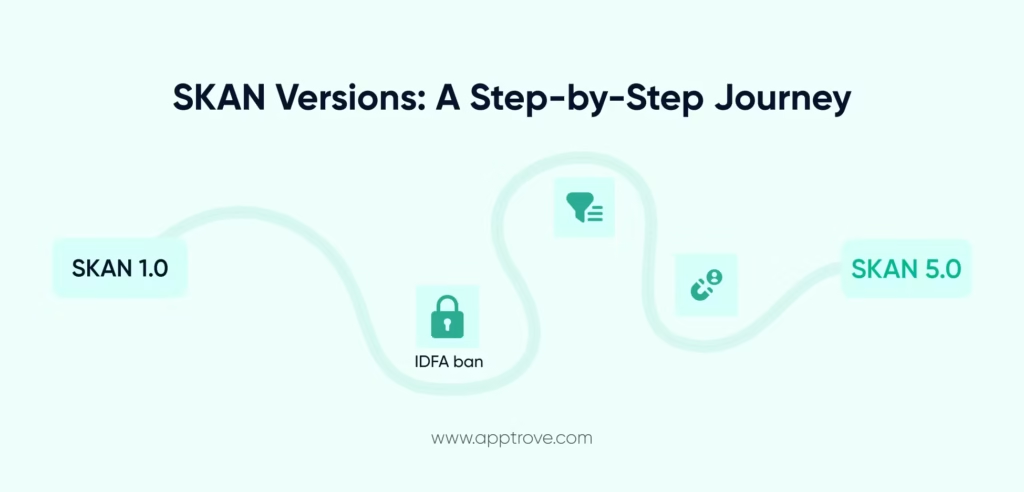
Since it first appeared, SKAdNetwork has gone through several major updates, each carefully designed to improve usefulness for advertisers while keeping Apple’s strict privacy standards. Here’s how the framework has changed:
SKAN 1.0 (iOS 11.3)
This version set the foundation of privacy-safe attribution. It confirmed app installs resulting from ad views or clicks, but provided extremely limited data with no conversion tracking or detailed reporting. While groundbreaking as an idea, its practical value for marketers was minimal.
SKAN 2.0 (iOS 14)
Apple greatly improved functionality by adding conversion values, creating a way for advertisers to track post-install actions such as sign-ups, purchases, or user engagement. This version also introduced source app ID, allowing for wider insights into where installs came from. Importantly, this version launched alongside ATT, making SKAN 2.0 the default backup attribution method for users who opted out of tracking.
SKAN 3.0 (iOS 14.6)
This update marked a major improvement: advertisers could now receive multiple reports rather than just a single notification. This change allowed for tracking additional in-app events beyond the initial install, though still limited by tight timing windows. SKAN 3.0 also added limited support for view-through attribution, filling an important gap in measurement ability.
SKAN 4.0 (iOS 16.1)
SKAN 4.0 represented a big step forward with several key additions. Coarse-grained conversion values (grouped as low, medium, high) were added to fine-grained values, helping improve signal quality when user-level detail wasn’t available due to privacy limits. Better source identifiers gave advertisers more context on specific ad campaigns while still protecting user identity. Perhaps most importantly, SKAN 4.0 introduced web-to-app attribution, letting marketers track installations that started from Safari browsing sessions.
SKAN 5.0 (iOS 17+ / 2024)
The newest version focuses heavily on measuring repeat visits, addressing a critical shortcoming of previous versions. For the first time, SKAN 5.0 supports attribution of app re-opens, a vital feature for subscription-based and e-commerce applications that depend on ongoing user engagement. With this update, Apple has further strengthened privacy protections while expanding SKAdNetwork’s usefulness for advanced measurement needs.
Each step in SKAN’s development represents a careful balance between meeting marketers’ measurement needs and maintaining Apple’s commitment to user privacy. Understanding these changes is essential for creating effective campaigns in today’s iOS environment.
How Does SKAN Actually Work?
At its heart, SKAdNetwork enables install attribution without revealing individual user identity. Here’s the process broken down:
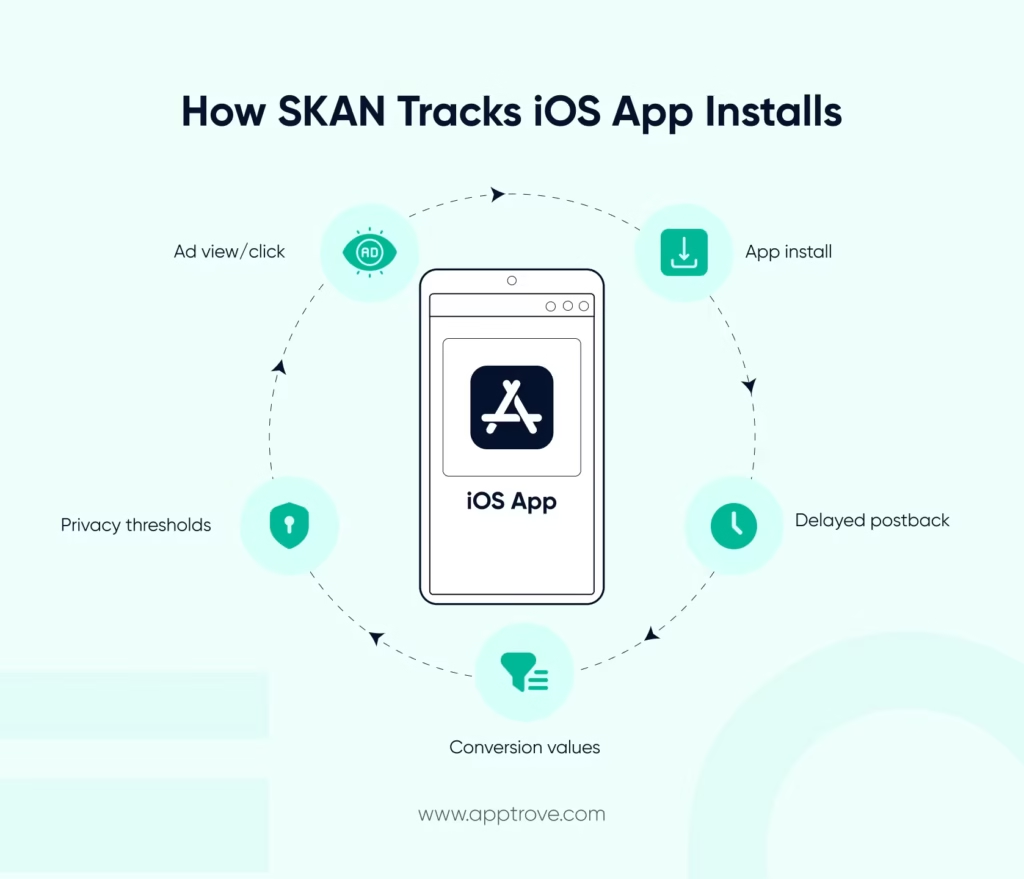
An ad is clicked or viewed, and SKAdNetwork records this interaction in a privacy-protecting manner. If the user then installs the app within a set window (24 hours), the install is marked as “attributed” – but this attribution isn’t reported right away. After a random delay period (typically 24–48 hours), a report is sent to the ad network containing anonymized data such as the conversion value and campaign ID.
This entire process happens without exposing any personally identifiable information whatsoever. While this represents a major win for privacy protection, it creates real challenges for measurement accuracy. The combination of timing delays, limited signal options, and strict privacy thresholds means marketers must completely rethink their approach to campaign measurement and fine-tuning.
This new reality makes specialized tools like Apptrove increasingly valuable. Such platforms offer enriched, SKAdNetwork-compliant data pipelines, easy-to-use dashboards designed specifically for SKAN’s unique requirements, and fraud filtering capabilities that make SKAN’s data more actionable and understandable in real marketing situations.
So… Why Should You Care About SKAN?
The answer is straightforward: if you’re advertising on iOS, you simply have no choice. Whether you’re a growth marketer focused on increasing app installations or a developer trying to understand why your campaign isn’t working as well as before, developing a solid understanding of SKAdNetwork has become absolutely necessary.
This new reality requires a complete rethinking of how you define success metrics, structure campaigns, interpret delayed and anonymized data, and work within the limits of privacy thresholds and attribution windows. Traditional KPIs may need replacement with new metrics like conversion value mapping. Campaign structures require SKAN-friendly frameworks that account for the system’s limitations.
In essence, SKAdNetwork isn’t just another feature addition – it represents an entirely new attribution ecosystem that demands new tools, fresh thinking, and potentially different partners who specialize in navigating this privacy-first world. With SKAN 5.0 currently rolling out, the learning needs continue to grow for iOS marketers.
Apple SKAdNetwork, Simplified
SKAN functions as Apple’s privacy-first attribution framework, replacing traditional IDFA-based tracking with anonymized signals. The system continues changing with each version (from SKAN 1.0 through the current 5.0), becoming increasingly critical for iOS install attribution in the post-ATT world. While definitely complex, SKAN becomes manageable with appropriate tools like Apptrove that specifically address its unique challenges.
Next, we’ll explore the inner workings of SKAN in greater detail, examining how reports function, how conversion values get assigned, and strategies for making practical sense of this new measurement reality.
The Mechanics of SKAdNetwork (SKAN)
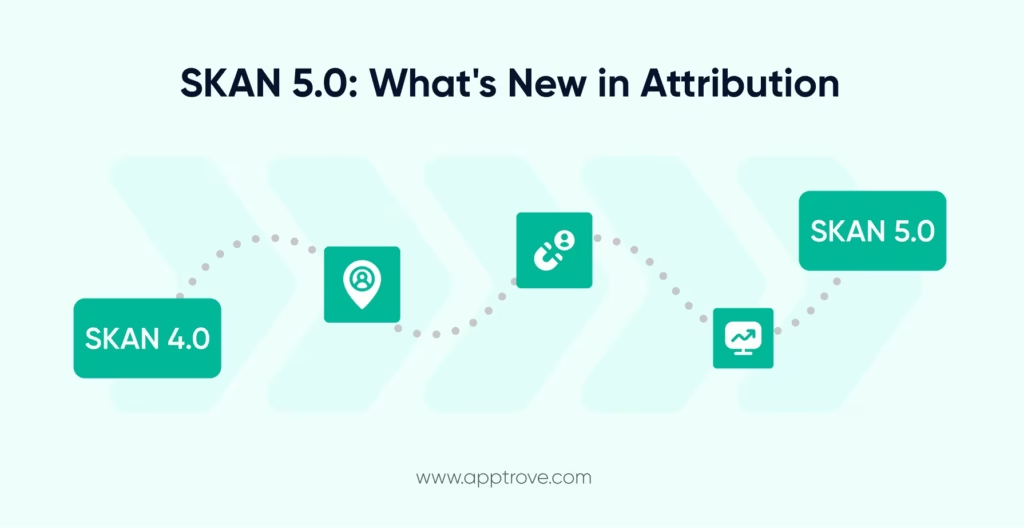
If you’ve ever felt like SKAdNetwork is a black box—where campaigns go in, but it’s unclear what you get out—you’re not alone. The mechanics behind SKAN can feel complex at first glance, but once you understand the logic, it begins to make sense. At its core, SKAdNetwork is Apple’s way of enabling attribution without hurting user privacy. But in doing so, it’s completely changed many rules that app marketers used to rely on. In fact, as of 2023, the global opt-in rate for Apple’s App Tracking Transparency (ATT) is around 25%, highlighting the significant challenge app marketers face in tracking user behavior across apps.
Let’s walk through how SKAN attribution really works, step by step, and explore the main components: postbacks, timers, conversion values, campaign identifiers, and the all-important privacy thresholds.
The Attribution Flow: From Ad Interaction to Postback
When a user clicks or views an ad for your app, SKAdWork starts working quietly behind the scenes. If the user installs the app within a certain timeframe, Apple attributes the install to that ad. But unlike traditional attribution models, you don’t get instant or detailed feedback. There’s no device-level data. Instead, Apple sends what’s called a postback—a delayed signal that confirms the install and shares a limited amount of metadata.
This delay is intentional. Apple adds random waiting periods between install and postback delivery to make it harder to trace the event back to an individual user. So, rather than real-time insights, you get anonymized, privacy-safe confirmation that your campaign worked… eventually.
Making Sense of Postbacks
Postbacks are the heartbeat of SKAdNetwork. They’re essentially tiny, encrypted packages sent from Apple to the ad network (and optionally to your measurement partner like Apptrove) that include only the essentials: a campaign identifier, a conversion value, and a timestamp range. If your campaign has met Apple’s privacy standards—more on that in a bit—you’ll also get finer details like user actions post-install.
From SKAN 1.0 through 3.0, only one postback was sent per user. That meant one chance to capture post-install behavior. But SKAN 4.0 changed the game by allowing multiple postbacks at different intervals, extending the attribution window to 35 days. These phased postbacks let advertisers better understand user engagement across time, though each postback still follows the same privacy-preserving logic.
Timers: The Hidden Delay Layer
One of the most challenging aspects of SKAN attribution is the timer system. The moment your app is opened post-install, a 24-hour conversion window starts. If the app reports a new conversion value within that time, the window resets. Apple only sends the postback once this timer runs out—and even then, the signal is held back by an additional random delay before delivery.
This system is designed to introduce enough fuzziness to prevent user re-identification. While it’s a win for privacy, it’s undeniably a pain point for marketers used to real-time data. But understanding the timing logic helps you better structure when and how you track post-install actions.
The Role of Conversion Values
To make up for the lack of user-level tracking, Apple introduced conversion values—numerical codes ranging from 0 to 63 that your app can assign to post-install actions. Think of it as a scoring system: you assign higher values to deeper engagement, like purchases or completed registrations.
SKAN 4.0 introduced coarse values—low, medium, and high—for cases where privacy thresholds aren’t met. This way, you still get some idea of engagement even when full details are masked. Crafting a smart conversion value schema is key to getting the most out of SKAdNetwork, and working with a platform like Apptrove can help automate and improve this process.
Campaign IDs, Source Identifiers, and Version Upgrades
Earlier versions of SKAdNetwork were limited by a simple 2-digit campaign ID, giving you only 100 combinations. This was often frustrating for marketers trying to break down performance by location, creative, or channel.
With SKAN 4.0, Apple introduced the source identifier—a much more flexible 4-digit code that gives you up to 10,000 configurations. It opens up room for better campaign design and reporting, but again, the detail you receive depends on whether the campaign meets privacy thresholds.
SKAN 5.0, rolling out in 2024 and beyond, goes a step further by adding support for re-engagement attribution. Now, you can track when inactive users return to your app due to a new campaign—a long-awaited feature for performance marketers who focus on lifetime value.
Privacy Thresholds: The Gatekeepers of SKAN Data
One of the trickiest (and most hidden) parts of SKAN is Apple’s privacy threshold system. If a campaign doesn’t receive enough installs or the user pool is deemed too narrow, Apple may strip away conversion values or suppress postbacks entirely. There’s no public documentation on these thresholds, and Apple doesn’t provide alerts when they’re triggered.
This means even a technically correct setup can result in missing data. Broad, high-volume campaigns tend to fare better, while niche or low-volume efforts may see limited attribution. It’s a balancing act between precision targeting and privacy compliance.
How Apptrove Helps You Decode the Chaos
There’s no denying it—SKAdNetwork can be a tough nut to crack. Between conversion values, timers, and privacy thresholds, it’s easy to feel lost in the noise.
Apptrove simplifies the process. With support for SKAN 4.0, our tools help you set up and manage conversion value strategies and make sense of phased postbacks through clear, privacy-friendly reporting. Whether you’re experimenting with coarse values or trying to structure smarter campaigns using source identifiers, Apptrove makes it a little easier to work within Apple’s rules, without the guesswork.
Why SKAN Matters for iOS Install Attribution

Before 2021, mobile attribution on iOS was fairly simple. Marketers heavily used the Identifier for Advertisers (IDFA), which let them track how users behaved across apps and create precisely targeted campaigns. It was the golden age of deterministic attribution—every tap, view, and install could be connected to a specific ad, channel, or campaign. But when Apple introduced App Tracking Transparency (ATT) and rolled out SKAdNetwork (SKAN), the rules changed dramatically.
For advertisers, app marketers, and developers, this shift wasn’t just technical—it was strategic.
From Full Visibility to a Privacy-Centric Black Box

When ATT was enforced, users could choose to opt out of tracking across apps. Most users did exactly that. In fact, opt-in rates stayed below 25% for most types of apps, creating a huge attribution blind spot for marketers. That’s where SKAN stepped in.
SKAN was Apple’s solution to this privacy puzzle: a system that allows attribution without showing any user-level data. But SKAdNetwork doesn’t work like traditional tools. It sends delayed, grouped reports instead of real-time, user-level insights. It also has privacy thresholds that, if not reached, result in missing or limited data. This means marketers need to rethink not just how they track installs, but how they define success.
Why This Matters More Than Ever
The loss of user-level detail changed how marketing budgets are planned and measured. Without deterministic attribution, concepts like return on ad spend (ROAS), customer lifetime value (LTV), and cost per acquisition (CPA) have become tougher to calculate accurately.
Enter SKAN. While it doesn’t offer the same level of transparency, it does provide a privacy-safe way to attribute installs and understand performance trends—if used wisely. It helps advertisers:
- Verify if a campaign led to a successful app install.
- Get limited yet structured feedback about in-app activity (via conversion values).
- Maintain compliance with Apple’s privacy expectations.
In essence, SKAdNetwork is not just a workaround—it’s Apple’s required attribution reality. And for any business looking to succeed on iOS, adapting to it isn’t optional.
New KPIs for a New Attribution World
Since SKAN limits the amount and detail of available data, marketers have started relying more on aggregate metrics and predictive modeling. Campaign improvements now involve creative testing, group-level analysis, and a greater focus on early metrics like click-through rates, install rates, and initial user behavior.
For example, instead of measuring exact revenue per user, marketers often rely on conversion value systems to define key post-install milestones, such as finishing onboarding, creating an account, or reaching a specific level in a game. These stand-ins help rebuild performance pictures while staying within SKAN’s rules.
This shift requires not just a change in thinking, but also tools that can simplify and enhance what limited data SKAdNetwork allows.
How Apptrove Supports iOS Attribution in the SKAN Era
Apptrove’s attribution system is designed to help app marketers handle this new normal. By working with SKAN 4.0, Apptrove makes report handling easier and helps teams build structured conversion value models that reflect real business outcomes.
Instead of struggling with delayed, fragmented data manually, marketers using Apptrove get access to a straightforward attribution dashboard that presents SKAdNetwork data in an actionable way. Whether it’s making sense of coarse values, interpreting phased reports, or dividing by source identifiers, Apptrove offers the tools to move from “what just happened?” to “what should we do next?”
In a world where every insight counts, having a reliable system that removes friction from SKAN attribution is more than helpful—it’s essential.
What is SKAN Attribution? And How Is It Different?
SKAN attribution, or SKAdNetwork attribution, is Apple’s way of tracking app installs and measuring ad performance without exposing your personal data. This isn’t just a small technical update—it fundamentally changes what marketers can measure, how they interpret data, and how they improve their campaigns on iOS.

In the past, mobile marketers relied on methods that directly linked users to campaigns using device identifiers like the IDFA. They could see exactly who clicked which ad, installed their app, and made purchases. Everything was detailed, immediate, and showed clear returns on investment. But this visibility came with privacy concerns.
As people became more protective of their data, Apple took action by limiting access to user identifiers unless people explicitly agreed to share them. With more users opting out, the old attribution methods quickly lost ground. By early 2024, SKAdNetwork handled over 40% of iOS attribution, showing a major shift in the industry toward privacy-focused measurement. SKAdNetwork has become the new normal for tracking app installs on iOS.
How SKAN Works (At a Glance)
SKAN attribution focuses on event confirmation, not tracking. When a user installs an app after engaging with an ad, the app reports that install to Apple, which then validates and attributes it to the relevant ad network. Instead of real-time data, SKAdNetwork sends delayed, anonymized reports containing high-level campaign information (like campaign ID and conversion values). No personal data is shared, and any signals are grouped together.
This may sound limiting, but it’s the privacy-safe foundation on which iOS attribution now stands.
SKAN vs. Legacy Attribution: The Big Differences

The most obvious shift is the move from detailed to general. SKAdNetwork doesn’t tell you who converted—it tells you that someone did. There are no timestamps, no user IDs, and no cross-device tracking. Attribution windows are limited. Data is delayed. And privacy thresholds can withhold data entirely if a campaign doesn’t generate enough installs.
Legacy attribution, by contrast, offered full-funnel, user-level journey tracking. You could fine-tune creatives and targeting with extreme precision. Now, marketers must adapt to a system that gives partial visibility, meaning strategies have to become broader, smarter, and more flexible.
Another key change is the reliance on conversion modeling. Since SKAN limits what can be measured post-install, developers use conversion values—numerical codes assigned to user actions—to estimate downstream performance. These values can be updated within a fixed post-install window, and SKAdNetwork then includes them in the install report.
Where SKAdNetwork Shines in App Marketing
Despite its limitations, SKAdNetwork is far from useless. In fact, many leading app marketers are learning to use it effectively, particularly for performance campaigns and improving early-funnel behaviors.
For example, in gaming, a developer might assign conversion values based on whether a user finishes the tutorial or reaches a certain level within 24 hours. For a fintech app, conversion values might reflect account creation or the first transaction. These small signals help teams estimate user quality even without long-term LTV data.
In categories with short user journeys—like casual gaming or utility apps—SKAN attribution can be more than enough for measuring campaign performance and adjusting spending.
Conversion Modeling: Rebuilding the Funnel
Since SKAdNetwork reports are delayed and anonymized, predictive modeling becomes crucial. By analyzing patterns in early user behavior (mapped to conversion values), marketers can predict likely outcomes such as in-app purchases or subscriptions. Machine learning models can also help fill in gaps where privacy thresholds suppress report delivery.
Apptrove, for instance, helps marketers build flexible conversion value models tailored to different app categories. Rather than guessing which early actions matter, you can design systems that tie back to revenue-driving behaviors, all while staying within SKAdNetwork’s limitations.
Real-World Use Cases (Privacy-Safe)
Let’s say a health & fitness app launches a paid campaign through a SKAdNetwork-certified ad network. Using SKAN 4.0, they set up a three-tiered conversion value strategy:
Low: App install with no further activity.
Medium: User signs up and sets fitness goals.
High: User completes a workout and enables push notifications.
When Apple sends the report 24 to 48 hours later, the conversion value gives the advertiser enough insight to assess campaign quality, without exposing user identity. Over time, this data can be used to shift budgets toward high-performing creatives or audiences.
In another example, an e-commerce app might assign conversion values based on whether a user browses categories, adds an item to the cart, or completes checkout. Although they can’t track exact purchase amounts like before, they still capture intent signals and adjust accordingly.
The Challenge of Data Discrepancies and Noise
Because of its privacy thresholds and delayed reporting, SKAdNetwork data often feels incomplete. If the number of installs in a campaign doesn’t reach Apple’s anonymity threshold, no report is sent. This can create confusion—marketers see impressions and clicks, but no attributed installs.
Then there’s the lack of consistency across ad networks. Some handle SKAN reports more effectively than others, leading to differences in data quality and quantity. Marketers often need to compare SKAdNetwork with MMP data, internal analytics, and even modeled projections to form a complete picture.
This makes noise filtering a core part of attribution today. Understanding which data is reliable, which is missing due to privacy thresholds, and how to fill those gaps is now part of the skillset every app marketer must develop.
Why This Matters Now
In a world where user-level data is becoming increasingly scarce, SKAdNetwork isn’t just a backup—it’s the new baseline. For brands relying on iOS for growth, adapting to SKAN attribution means rethinking KPIs, changing campaign structures, and rebuilding measurement strategies from scratch.
Apptrove helps bring order to this complexity. Our attribution engine aligns closely with SKAN 4.0 standards, helping app marketers interpret reports, build effective conversion value schemas, and reduce noise in measurement. With tools designed to uncover insights from even the most limited SKAdNetwork data, Apptrove empowers marketers to make confident, data-backed decisions.
The Evolution of SKAN: From Quiet Beginnings to Attribution Powerhouse
Remember when Apple quietly introduced SKAdNetwork (SKAN) back in iOS 11.3? Most of us barely noticed it. Fast forward to today’s post-IDFA world, and SKAdNetwork has become the cornerstone of iOS install attribution. Let’s take a journey through SKAN’s transformation, seeing how each version has reshaped mobile marketing while maintaining Apple’s privacy-first approach.

SKAN 1.0: The Humble Beginning
When Apple first launched SKAN with iOS 11.3, it was remarkably basic. The idea was simple: provide a way to attribute app installs without exposing user identifiers. When someone tapped an ad and downloaded your app, Apple would verify the install and send a notification to the ad network.
But let’s be honest—the limitations were glaring:
- You’ve got just one install postback per user
- There was zero visibility into what happened post-install
- Campaign-level insights? Forget about it
For performance marketers used to detailed user journeys, SKAN 1.0 felt like driving with foggy windows. It technically worked, but you couldn’t see enough to optimize effectively.
SKAN 2.0: The Privacy Revolution Begins
SKAN 2.0 arrived alongside Apple’s game-changing App Tracking Transparency (ATT) framework, marking the official beginning of the privacy-first era in mobile marketing. This update brought two crucial improvements:
- Conversion values: Finally! Developers could assign a 6-bit value (0-63) to track post-install actions, giving us a glimpse into user behavior after the download
- Source app ID: Marketers could now see which app actually served the converting ad
For the first time, we had a limited window into post-install behavior—albeit with significant constraints like strict timers and delayed reporting. SKAN 2.0 made iOS install attribution viable, but still felt restrictive, especially for apps with complex user journeys or delayed conversion events.
SKAN 3.0: Building Attribution Momentum
With iOS 14.6, Apple addressed a key limitation by introducing multiple postbacks. Suddenly, advertisers could receive more than one attribution signal per user, though still with the same privacy protections.
The addition of view-through attribution was particularly meaningful. No,w impressions (not just clicks) could get credit for driving installs. For anyone running video campaigns or upper-funnel awareness ads, this was a breath of fresh air.
Yet SKAN 3.0 still lacked context around creative performance, audience segments, and deeper engagement metrics. The SKAdNetwork attribution data was becoming more useful, but remained incomplete.
SKAN 4.0: The Attribution Game-Changer
iOS 16.1 brought the most comprehensive SKAdNetwork overhaul yet, dramatically expanding what marketers could measure while staying within Apple’s privacy guardrails.
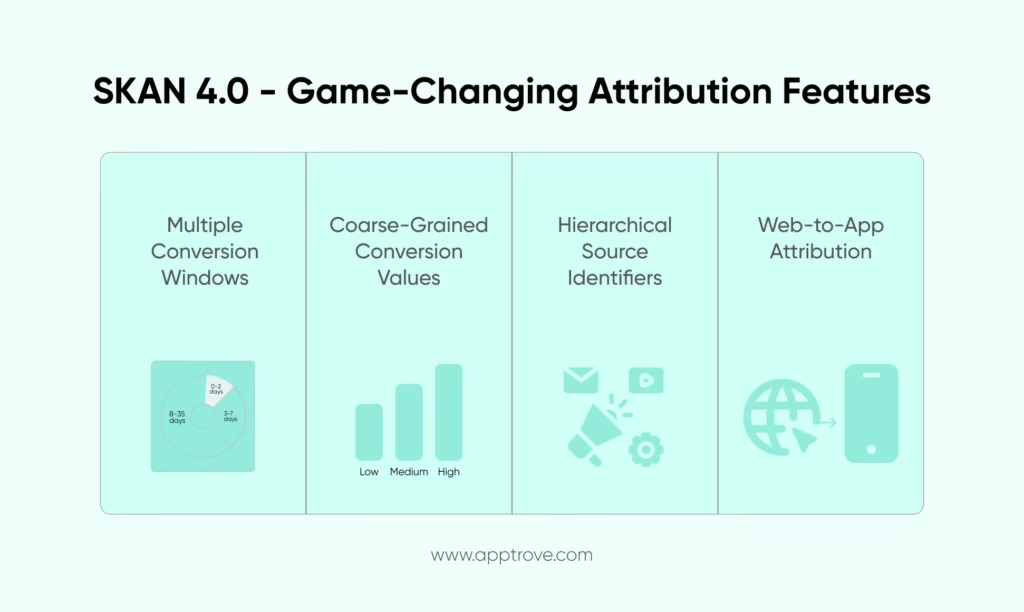
The upgrades were substantial:
- Multiple conversion windows: Up to 3 postbacks at different intervals (0-2 days, 3-7 days, and 8-35 days), giving visibility into user behavior over a much longer period
- Coarse-grained conversion values: When privacy thresholds aren’t met, you can still get “low, medium, high” signals instead of nothing
- Hierarchical source identifiers: A flexible 4-digit system for organizing campaigns and sub-campaigns, enabling much more sophisticated testing
- Web-to-app attribution: Finally bridging the gap for web campaigns driving app installs
With SKAN 4.0, marketers gained the tools to build attribution models with actual depth. It represented a major step toward making SKAdNetwork attribution both useful and privacy-compliant.
SKAN 5.0: The Next Frontier (Coming Soon)
While SKAN 5.0 has been announced for 2024, it hasn’t launched yet. The biggest anticipated feature is support for re-engagement campaigns—something marketers have requested for years. This will finally allow attribution when users who already have your app return because of a new ad campaign.
Since SKAN 5.0 is still in preview, most marketers (including those using Apptrove) are focused on mastering SKAN 4.0 before preparing for the next evolution.
Why These SKAN Versions Matter to App Marketers
Each version of SKAdNetwork has addressed specific challenges marketers face in a privacy-focused environment. The early versions helped us survive the initial post-IDFA transition, but SKAN 4.0 is the first version that genuinely supports strategic campaign optimization.
If your app has longer user journeys, relies on creative testing, or needs performance signals beyond the first day after install, SKAN 4.0 provides meaningful solutions. The combination of coarse conversion values and hierarchical campaign structures means you no longer have to choose between precision and scale—you can design attribution frameworks that respect privacy while still delivering actionable insights.
Enhancing SKAN Attribution with Apptrove’s Unilink
With SKAN 4.0 supporting web-to-app attribution, one of the more complex challenges has been managing deep links while maintaining privacy, especially when users move between platforms before installing.
This is where Apptrove’s Unilink feature becomes invaluable. It’s specifically designed to complement the SKAdNetwork attribution flow, handling deep linking across channels (ads, emails, websites) while preserving tracking integrity within Apple’s guidelines. With Unilink, you can create seamless user journeys from web campaigns to App Store installs, while still receiving proper attribution through the SKAdNetwork framework.
Whether you’re running paid mobile web ads or driving App Store traffic from organic content, Unilink ensures your attribution chain remains intact throughout the user journey.
Want to understand how deep links work behind the scenes? Check out our deep linking glossary.
Mastering SKAN Campaign Optimization in the Privacy Era
The evolution of SKAdNetwork (SKAN) demands a more thoughtful approach to iOS campaign optimization. Unlike traditional attribution, where you could track individual user journeys, SKAN requires working within Apple’s privacy framework while still striving for campaign effectiveness. The key is understanding what you can and cannot control within Apple’s ecosystem and adapting your strategies accordingly.
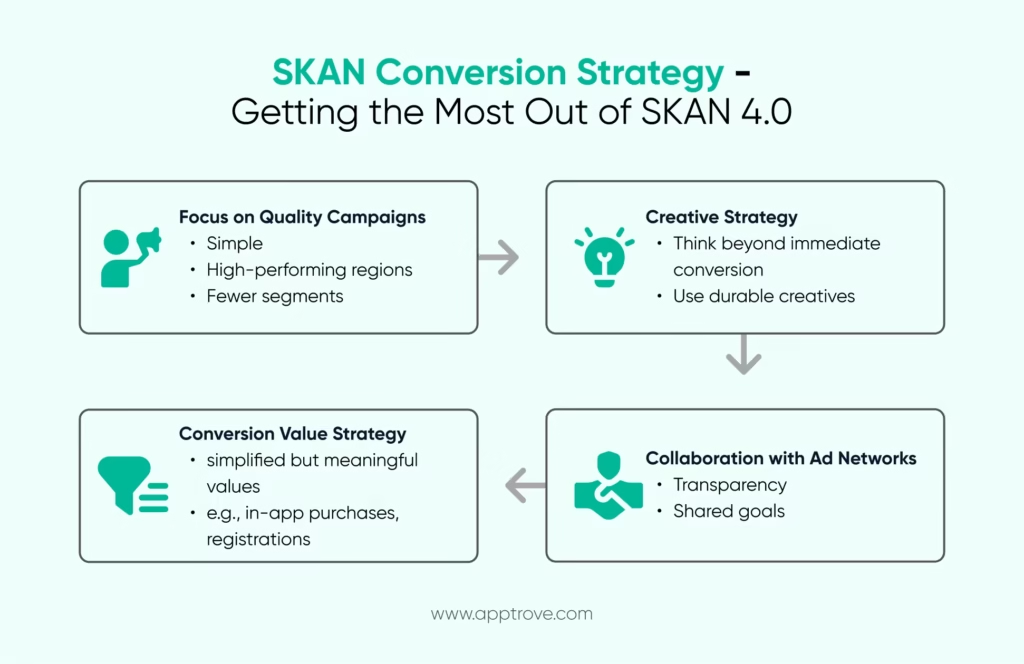
Campaign Structure: Quality Trumps Quantity
With SKAN, you need to embrace a new reality: campaign simplicity delivers better insights than complex segmentation. Apple limits your concurrent campaign IDs, making each one precious. Rather than launching dozens of test variants, successful marketers now focus on carefully designed campaigns that isolate specific variables. The introduction of hierarchical identifiers in SKAN 4.0 offers improved granularity while maintaining privacy, but this doesn’t mean unlimited segmentation is possible.
Consider grouping campaigns by your highest-performing geographical regions or app categories instead of fragmenting your budget across too many segments. Limit creative variants within each campaign to clearly measure their impact without muddying the data. Many leading iOS marketers have developed systematic approaches to mapping source identifiers to their internal metadata, creating a translation layer that enhances signal interpretation without violating SKAN’s privacy protections.
Creative Strategy: Thinking Beyond Immediate Conversion
SKAN attribution has fundamentally changed how we evaluate creative performance. With delayed postbacks and limited conversion values, marketers must think more holistically about creative impact rather than focusing solely on immediate response metrics. The most successful campaigns now utilize what some call “durable creatives”—assets designed to perform consistently across longer windows and multiple audience segments.
High-impact visuals, crystal-clear value propositions, and thoughtful localization typically show stronger performance under SKAN’s constraints. A/B testing remains valuable but requires more precision about measurement goals. The question isn’t simply what creative drives more installs, but what creative drives the right kind of user behavior within the timeframes that SKAN can actually measure.
Creative sequencing has also taken on new importance in the SKAN world. By thoughtfully planning how your messaging unfolds across multiple impressions, you can guide user behavior over time even when immediate feedback is limited by SKAdNetwork’s privacy protections. This requires thinking about creative strategy as a journey rather than a series of isolated tests.
Conversion Value Strategy: Make Every Bit Count
With limited feedback from SKAN attribution, your conversion value schema becomes perhaps the most critical element of campaign optimization. A well-designed model effectively translates complex user behavior into compact, SKAN-compliant signals that can guide your optimization decisions. The best schemas align perfectly with your app’s genuine value moments, whether those are registrations, purchases, subscriptions, or engagement milestones.
Gaming apps often prioritize in-app purchases or level completions in their conversion schemas, while fintech applications might focus on KYC completion or first deposits. The challenge lies in capturing these meaningful events within SKAN’s time constraints while balancing simplicity with insight richness. Too simple, and you miss crucial behavior patterns; too complex, and you create noise that masks the true signals. Regular review and refinement of your conversion mapping as user behavior and product flows evolve ensures your schema remains relevant.
Ad Network Collaboration: Partners in Limited Visibility
While SKAN attribution creates significant data limitations, working effectively with ad networks remains crucial for campaign success. Many networks have developed SKAN-specific reporting capabilities to help fill knowledge gaps, but relying exclusively on their interpretations can be risky. The most sophisticated marketers validate external insights against their internal measurement models, creating a more complete picture of campaign performance.
Establishing transparent workflows with your advertising partners involves sharing your conversion schema and campaign mapping logic so everyone understands what the signals mean. Requesting data exports aligned with your specific SKAN version ensures compatibility, especially important when leveraging the newer features of SKAN 4.0. Agreement on performance windows and postback timelines creates reporting clarity that benefits both parties. This collaborative approach ensures consistent interpretation of the limited but valuable signals that SKAdNetwork provides.
Apptrove’s Approach to SKAN Optimization
At Apptrove, we understand that optimizing iOS install attribution through SKAN requires delicately balancing privacy requirements with performance needs. Our tools are designed to reduce friction throughout the attribution workflow, enhancing campaign analysis by enriching SKAN postbacks with additional contextual metadata that makes signal interpretation more intuitive. Our anomaly detection systems identify suspicious traffic patterns that might otherwise go unnoticed in the limited SKAN data environment, and we’ve developed methods to simplify creative-level analysis despite SKAN’s value limitations.
The platform supports quick reconfiguration of conversion schemas, enabling faster iteration as your app goals evolve. With comprehensive support for dynamic postback interpretation across different SKAN versions, we ensure you maintain visibility even when signals are limited by privacy constraints. This adaptive approach helps marketers extract maximum value from SKAdNetwork attribution while respecting Apple’s privacy framework.
The Long Game: Patience and Pattern Recognition
Perhaps the most important aspect of SKAN optimization is embracing patience as a strategy. Unlike previous attribution systems with near-instantaneous feedback, SKAN presents a gradual learning process where meaningful patterns emerge over weeks rather than hours. Success depends on building your strategy incrementally, assessing changes contextually, and refining based on longer feedback cycles than marketers were previously accustomed to.
The most successful SKAN marketers adjust their bid strategies based on observed patterns in coarse-grained outcomes rather than chasing daily fluctuations. They continuously revisit measurement KPIs to ensure alignment with the realities of privacy-era data flows. When early conversion data is limited, they incorporate sophisticated modeling of lifetime value to fill the gaps. SKAN campaign optimization isn’t about chasing instant wins or reacting to hourly performance shifts—it’s about developing sustainable growth strategies that function effectively within Apple’s privacy-focused attribution framework. This longer-term perspective ultimately delivers more stable performance in the increasingly privacy-centric iOS ecosystem.
SKAN Reporting & Interpretation: Extracting Meaning from Limited Signals
Once your SKAdNetwork (SKAN) campaigns are up and running and the data starts coming in, you’ll find yourself facing a new challenge, figuring out what all these numbers actually mean. When you’re dealing with delayed information, limited data points, and privacy thresholds that determine what gets reported, making sense of SKAN attribution requires a completely different mindset than what you were used to before Apple’s privacy changes.
But here’s the good news: the feedback loop isn’t broken, it’s just playing by different rules now. By getting comfortable with how SKAN reporting works and adjusting how you analyze things, you can still discover valuable insights to guide your iOS marketing decisions. Notably, as of January 2024, SKAdNetwork Version 4 had an adoption rate of 33%, reflecting its growing prominence in the iOS attribution landscape.
The Anatomy of SKAN Postbacks

SKAN postbacks represent Apple’s privacy-safe way of confirming that an install occurred, connecting it to a campaign ID and providing a conversion value representing user actions within a limited timeframe. Depending on which SKAN version you’re using and whether privacy thresholds are met, this data arrives with varying levels of detail.
SKAN postbacks have several distinctive characteristics that influence how they should be interpreted. The intentional time delay built into the system means postbacks don’t arrive immediately—they can take anywhere from 24 to 72 hours, depending on the SKAN version and user activity detected. This deliberate delay is part of Apple’s privacy design, ensuring individual users remain unidentifiable within the attribution data.
With SKAN 4.0, Apple introduced an important distinction between “coarse-grained” and “fine-grained” conversion values. When a campaign doesn’t meet certain volume thresholds, you’ll receive simplified “low, medium, or high” coarse values instead of the more detailed 64-level granularity of fine values. This tiered approach ensures that some signal gets through even when privacy protections are activated.
The concept of crowd anonymity forms the foundation of Apple’s privacy guardrails within SKAdNetwork attribution. If a campaign doesn’t generate sufficient volume or quality signal, postbacks may be suppressed entirely or stripped of sensitive data fields like conversion values or source identifiers. This isn’t a penalty for poor performance—it’s simply how Apple maintains its privacy-first approach to iOS install attribution.
Transforming Fragmented Data into Functional Insights
Unlike traditional attribution systems that provided user-level data and real-time visibility, SKAN offers aggregated, probabilistic snapshots. Rather than analyzing each postback as an isolated event, successful marketers extract insights by identifying patterns and trends that emerge over time.
A robust SKAdNetwork reporting strategy focuses on group-level analysis instead of individual user journeys. Breaking down campaign performance by broader segments like creative approaches, geographical regions, or traffic sources becomes the primary method for understanding what’s working. The hierarchical campaign IDs and source identifiers within SKAN provide the foundation for this segmentation approach.
The delayed nature of SKAN postbacks requires adjusting your reporting timelines accordingly. Campaigns launched today won’t show complete data for several days, making lookback normalization essential for accurate assessment. Marketing teams that successfully adapt to SKAN attribution learn to align their reporting windows with these delayed signals rather than expecting immediate feedback.
Looking beyond raw install counts becomes crucial in the SKAN environment. Layering in conversion values—whether fine or coarse—alongside revenue estimates, modeled lifetime value projections, or retention signals provides a more complete picture. Even when only a portion of postbacks contain full conversion data due to privacy thresholds, meaningful trends can still emerge when viewed at scale and over time.
The SKAN reporting environment includes expected discrepancies and data loss by design. Successful interpretation involves identifying consistent patterns while understanding where gaps are most likely to appear, particularly in low-volume campaigns or lower-quality traffic sources. This contextual awareness prevents misinterpretation of missing data as campaign failure.
Apptrove’s Approach to SKAN Reporting Clarity
At Apptrove, we recognize how disorienting SKAdNetwork data can feel, especially for marketing teams accustomed to detailed, user-level analytics from the pre-ATT era. Our attribution platform includes a specialized SKAN dashboard designed specifically to cut through the complexity and provide marketers with practical, actionable clarity.
Our reporting tools address the unique challenges of SKAdNetwork attribution by visualizing delayed signals along expected timelines, helping you understand not just what data you’re seeing now, but what additional information to expect in the coming days. This temporal mapping aligns SKAN postbacks with your internal metrics for more coherent analysis.
We’ve developed intelligent systems for segmenting conversion value clusters, whether fine-grained or coarse-grained, allowing campaign comparison without confusion about Apple’s classification mechanisms. Our platform automatically flags postbacks missing key fields due to privacy thresholds and highlights areas where data loss might be impacting your interpretation, preventing you from making decisions based on incomplete signals.
The behavioral differences between SKAN 3 and SKAN 4 can create significant confusion when analyzing attribution data. Our interface maintains clear distinctions between these versions, eliminating the need to manually track version-specific behaviors or wonder why certain metrics appear differently across campaigns using different SKAN implementations.
Apptrove’s commitment goes beyond simply displaying raw SKAdNetwork data—we focus on helping you understand what that data actually means and how you can apply those insights to improve campaign performance within Apple’s privacy framework. The goal isn’t just to show you the signals, but to help you extract genuine meaning from them despite the inherent limitations of iOS install attribution in the privacy era.
Common Challenges & How to Overcome Them
Even with its privacy-first promise, SKAdNetwork isn’t without its hurdles. For app marketers and advertisers, the reality of working with SKAdNetwork often means adjusting to a new way of thinking—one that trades clarity for compliance and leaves behind many of the signals they previously relied on.
The journey through SKAN attribution comes with several significant challenges that require strategic adaptation. Understanding these obstacles—and how to navigate them—can make the difference between frustration and success in the post-IDFA world.
The Frustrating Lag: Delays in Postback Data

One of the most persistent challenges with SKAdNetwork is the delay in receiving attribution data. Because SKAdNetwork waits for a conversion window to close and then applies a random timer before sending postbacks, marketers no longer get real-time insights. This means campaign decisions, which once relied on instant feedback, now require a more patient and predictive approach.
While the delay is a deliberate design choice to prevent fingerprinting and uphold user privacy, it introduces considerable guesswork, especially for teams accustomed to optimizing campaigns on the fly. Successful adaptation often means setting up campaigns with longer evaluation windows and learning to read performance trends more holistically. Many marketing teams have developed intermediate metrics and proxies that help bridge the gap during these waiting periods, allowing for provisional optimization while SKAdNetwork attribution data slowly filters in.
Limited Granularity: The Coarse vs. Fine Value Dilemma
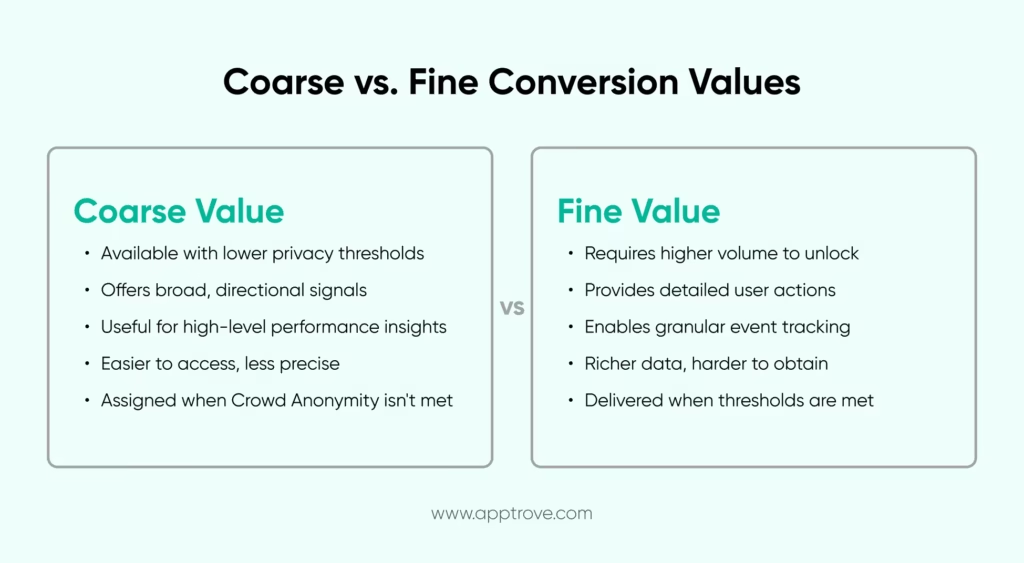
SKAN 4.0 introduced the concept of coarse and fine conversion values, adding more flexibility but also more complexity to iOS install attribution. Fine values offer more detailed insight but are only available under certain conditions, such as meeting Apple’s crowd anonymity threshold. When these thresholds aren’t met, advertisers receive only coarse values, which provide broader and less informative signals about user behavior.
This inconsistency makes performance tracking particularly challenging. What appeared to work effectively yesterday may look incomplete today, not because actual performance declined, but because the privacy threshold wasn’t met for that particular segment. Marketers must now anticipate these data gaps and build analytical models that can operate effectively with fragmented or inconsistent information. Developing conversion schemas that extract meaningful signals even from coarse values has become an essential skill in the SKAN environment.
Apple’s Privacy Thresholds: Invisible Rules, Real Impact

Privacy thresholds represent one of the least understood yet most impactful aspects of SKAdNetwork attribution. Apple intentionally doesn’t reveal exactly when a campaign qualifies for detailed reporting. This “black box” approach creates unpredictability—two seemingly identical campaigns might yield vastly different data quality depending on volume, user behavior patterns, and crowd anonymity calculations that remain hidden from marketers.
The most effective strategy for addressing this challenge is scaling campaigns thoughtfully. Higher volume often helps meet thresholds more consistently, which leads to better data quality and more complete attribution signals. While this approach isn’t always feasible for smaller apps with limited budgets, creative campaign structuring, such as narrowing geo-targeting or consolidating related ad sets, can help maintain a healthier signal-to-noise ratio even with modest spending levels.
Mapping Conversions & Cohorts: The Creative Challenge
Before SKAdNetwork, marketers could analyze user cohorts with remarkable precision, tracking day 0 installs, day 7 revenue, retention by source, and countless other metrics. SKAdNetwork severely restricts this visibility. With conversion values tied to limited windows (typically within 24–72 hours), and postbacks stripped of granular user-level insights, traditional cohort analysis becomes significantly less precise.
This limitation forces marketing teams to think differently about measurement. Instead of tracking individual user journeys, they must design conversion value schemas that broadly reflect performance through indicators like engagement tiers or revenue brackets. While this represents a significant compromise compared to previous attribution capabilities, it’s a necessary adaptation to the realities of iOS install attribution in the SKAN framework.
How Apptrove Helps Smooth the Ride
Apptrove’s platform is specifically designed to reduce much of this operational friction. Our system is built with SKAN’s limitations as a foundational consideration, offering intelligent support for conversion value configuration, postback interpretation, and aggregated reporting that works within Apple’s privacy constraints.
By reimagining how postbacks are structured and visualized, Apptrove’s dashboards make it substantially easier to identify meaningful trends beyond raw numbers. We help clients develop conversion models that balance flexibility with informative value, ensuring that even when attribution data arrives as coarse signals or with significant delays, there’s still a clear directional understanding of campaign performance.
Our privacy-compliant attribution layers are engineered to provide additional context in areas where Apple’s framework creates gaps, without violating SKAdNetwork’s fundamental rules. Whether helping identify underperforming creative assets or refining campaign structures to meet reporting thresholds more consistently, Apptrove offers practical solutions to the everyday challenges marketers face in the SKAdNetwork attribution environment.
The Future of iOS Attribution
With each new version, Apple has made it increasingly clear that SKAdNetwork is not just a temporary solution—it’s the foundation for the future of attribution on iOS. While SKAN 5.0 hasn’t officially rolled out yet, its anticipated features are already shaping how advertisers and app developers approach measurement strategies for 2025 and beyond.
A Glimpse into SKAN 5.0
Though still unreleased, SKAN 5.0 is expected to introduce re-engagement tracking capabilities, addressing one of the most significant gaps in the current attribution framework. If implemented as previewed, this would finally allow marketers to understand not just new user acquisition but also how existing users interact with campaigns after installation. This represents a substantial step toward closing the loop in understanding user behavior, while still operating within Apple’s privacy guidelines.
Industry experts anticipate that Apple will continue refining its crowd anonymity mechanisms, potentially offering more granular attribution data without compromising user identity protection. This evolution, while not revolutionary, could prove particularly valuable for growth-stage apps and performance marketers who require deeper insights without sacrificing privacy compliance.
Privacy-Enhanced Frameworks on the Rise
The shift toward privacy-centric attribution extends beyond just SKAdNetwork. Across the digital marketing landscape, we’re witnessing a fundamental transition toward privacy-enhanced measurement frameworks. Google’s Privacy Sandbox for Android, for example, follows a similar philosophical trajectory. The industry is gradually aligning around a future where traditional identifiers become obsolete, replaced by contextual signals and aggregated data models as the new standard.
For marketing professionals, this transformation makes adaptation non-negotiable. First-party data strategies, sophisticated probabilistic modeling techniques, and enhanced contextual targeting capabilities are no longer optional enhancements—they’ve become essential building blocks for any sustainable growth strategy in mobile marketing. The most forward-thinking organizations are already investing heavily in these capabilities, recognizing that the privacy-first paradigm represents the new permanent reality.
Why Hybrid Measurement Models Matter
The limitations of any single attribution framework have made it clear that no isolated approach provides a complete performance picture anymore. This realization has driven the development of hybrid measurement models that combine multiple data sources and methodologies. Integrating SKAN attribution with server-side events, incrementality testing protocols, or media mix modeling helps fill the information gaps created by Apple’s privacy-focused system. This blended approach allows marketers to extract substantially more value from fewer direct signals, maximizing actionable insights while maintaining full compliance with privacy regulations.
How Apptrove Is Preparing
At Apptrove, we’re actively monitoring SKAN 5.0 developments while simultaneously helping clients future-proof their attribution infrastructure. Although we haven’t yet launched specific SKAN 5.0 support, given its pending rollout status, our current focus remains on making the existing SKAN 4.0 implementation more actionable, scalable, and transparent for our partners.
We firmly believe the future of mobile marketing is privacy-first, but that doesn’t mean it must be insight-deprived. Our product roadmap reflects this philosophy, with concentrated efforts on bridging the gap between currently available capabilities and anticipated future developments in the attribution landscape.
Final Takeaways & Resources
The SKAdNetwork journey presents significant challenges, but mastering it has become essential for success in iOS marketing. As privacy expectations continue evolving, so must our approaches to measuring performance, analyzing user behavior patterns, and planning effective campaigns.
Throughout this comprehensive guide, we’ve explored everything from understanding the fundamental mechanics of SKAN postbacks to optimizing conversion values and adapting to the specific limitations of SKAN 4.0. Whether you’re a growth marketing specialist, user acquisition manager, or app developer, it’s become abundantly clear that previous playbooks will no longer deliver results. Achieving precision in this privacy-first environment requires working smarter, not just harder, with the limited but valuable signals available.
Tools like Apptrove help transform this challenging landscape into manageable territory. With intuitive, customizable dashboards, SKAdNetwork-compliant attribution methodologies, and specialized support for conversion value modeling, our system was purposefully designed to help app marketers extract maximum value from every available data point, regardless of how limited those signals might initially appear.
If you’re ready to turn SKAN confusion into clarity, we’d love to talk.
